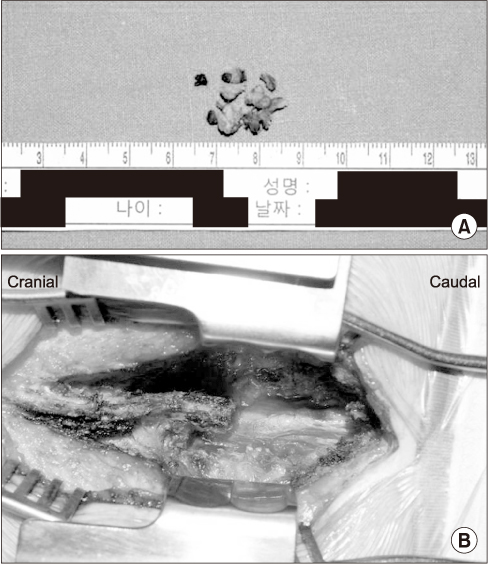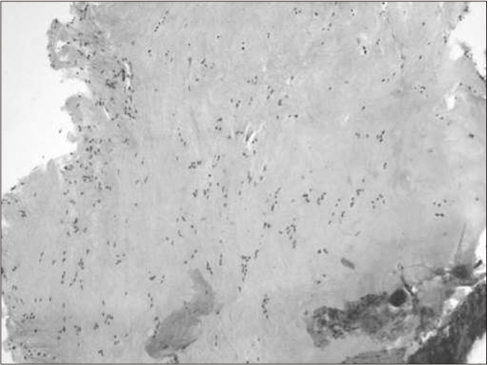J Korean Orthop Assoc.
2019 Aug;54(4):361-365. 10.4055/jkoa.2019.54.4.361.
Cauda Equina Syndrome Occurred by Adhesive Arachnoiditis of the Lumbar Spine with an Unknown Cause
- Affiliations
-
- 1Department of Orthopedic Surgery, Sung-Ae Hospital, Seoul, Korea. j9422hs@hanmail.net
- KMID: 2455505
- DOI: http://doi.org/10.4055/jkoa.2019.54.4.361
Abstract
- Spinal adhesive arachnoiditis is an inflammation and fibrosis of the subarachnoid space and pia mater caused by infection, trauma, spinal vascular anomalies, and iatrogenic (surgery and/or puncture). Adhesive arachnoiditis develops various symptoms and signs (gait disturbances, radiating pain, paralysis, and incontinence). On the other hand, adhesive arachnoiditis associated with cauda equina syndrome has not been reported in Korea until now. The authors experienced cauda equina syndrome caused by adhesive arachnoiditis of the lumbar spine with satisfactory results following decompression. We report this case with a review of the relevant literature.
MeSH Terms
Figure
Reference
-
1. Whetstone KE, Crane DA. Cauda equina syndrome resulting from lumbar arachnoiditis after intracranial subarachnoid hemorrhage: a case report. PM R. 2013; 5:539–541.
Article2. Augustijn P, Vanneste J, Davies G. Chronic spinal arachnoiditis following intracranial subarachnoid haemorrhage. Clin Neurol Neurosurg. 1989; 91:347–350.
Article3. Faure A, Khalfallah M, Perrouin-Verbe B, et al. Arachnoiditis ossificans of the cauda equina. Case report and review of the literature. J Neurosurg. 2002; 97:239–243.4. Quiles M, Marchisello PJ, Tsairis P. Lumbar adhesive arachnoiditis. Etiologic and pathologic aspects. Spine (Phila Pa 1976). 1978; 3:45–50.5. Bourne IH. Lumbo-sacral adhesive arachnoiditis: a review. J R Soc Med. 1990; 83:262–265.
Article6. Bilgen IG, Yunten N, Ustun EE, Oksel F, Gumusdis G. Adhesive arachnoiditis causing cauda equina syndrome in ankylosing spondylitis: CT and MRI demonstration of dural calcification and a dorsal dural diverticulum. Neuroradiology. 1999; 41:508–511.
Article7. Delamarter RB, Ross JS, Masaryk TJ, Modic MT, Bohlman HH. Diagnosis of lumbar arachnoiditis by magnetic resonance imaging. Spine (Phila Pa 1976). 1990; 15:304–310.
Article8. Petty PG, Hudgson P, Hare WS. Symptomatic lumbar spinal arachnoiditis: fact or fallacy? J Clin Neurosci. 2000; 7:395–399.
Article
- Full Text Links
- Actions
-
Cited
- CITED
-
- Close
- Share
- Similar articles
-
- Adhesive Arachnoiditis of the Lumbar Spine after Endoscopic Discectomy - A Case Report -
- Posterior Epidural Migration of a Sequestrated Intervertebral lumbar Disc with Cauda Equina Syndrome: Two Cases Report
- Thoracic Spine Tumor Mimicking Cauda Equina Syndrome
- Diagnosis and Treatment of Cauda Equina Arachnoiditis, a Rare Manifestation of Tuberculosis Meningoencephalitis: A Case Report
- Dorsally Migrated Sequestrated Lumbar Disc Herniation with Cauda Equina Syndrome: Two Cases Report





